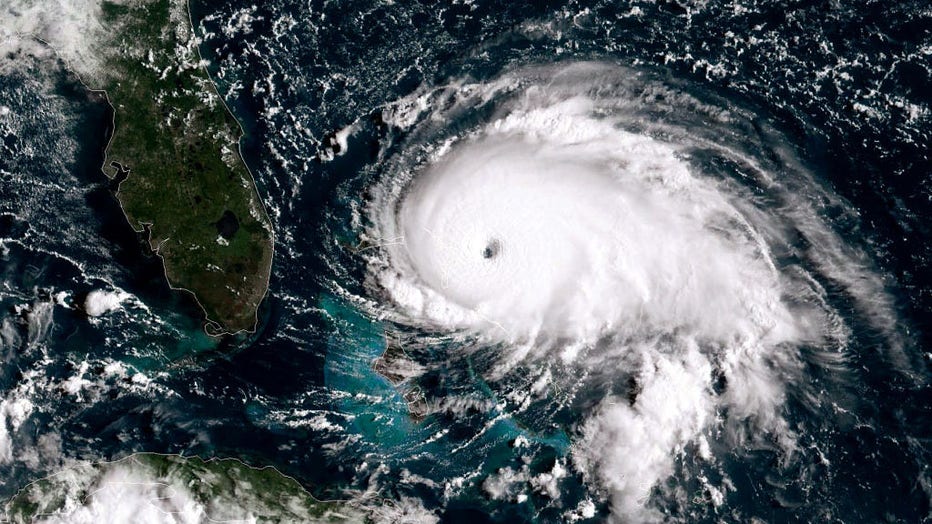Back-to-back hurricanes likely to come more often, simulation finds
What used to be a rare one-two punch of consecutive hurricanes hitting about the same place in the United States weeks apart seems to be happening more often, and a new study says climate change will make back-to-back storms more frequent and nastier in the future.
Using computer simulations, scientists at Princeton University calculate that the deadly storm duet that used to happen once every few decades could happen every two or three years as the world warms from the burning of coal, oil and natural gas, according to a study in Monday’s Nature Climate Change.
Louisiana and Florida residents have already felt it.

In this NOAA GOES-East satellite handout image, Hurricane Dorian, now a Cat. 5 storm, tracks towards the Florida coast taken at 13:20Z September 1, 2019 in the Atlantic Ocean. (Photo by NOAA via Getty Images)
In 2021, major Hurricane Ida blasted Louisiana with 150 mph winds. Just 15 days later a weakening Nicholas came nearby, close enough for its wind, rain and storm surge to add to the problems, said study co-author Ning Lin, a risk engineer and climate scientist at Princeton. Her study looked at not just the storms but the problems back-to-back hurricanes caused to people.
The Ida-Nicholas combo came after Louisiana was hit in 2020 by five hurricanes or tropical storms: Cristobal, Marco, Laura, Delta and Zeta. Laura was the biggest of those, packing 150-mph winds.
After Laura, relief workers had set up a giant recovery center in a parking lot of a damaged roofless church when Delta approached, so all the supplies had to be jammed against the building and battened down for the next storm, said United Way of Southwest Louisiana President Denise Durel.
"You can't imagine. You're dumbfounded. You think it can't be happening to us again," Durel recalled 2 1/2 years later from an area that is still recovering. "The other side of it is that you can't wish it upon anyone else either."

What's the difference between a Tropical Depression, Tropical Storm, and Hurricane?
Tropical Depressions, Tropical Storms, and Hurricanes all have different characteristics that are compared and contrasted in this video.
Florida in 2004 had four hurricanes in six weeks, prompting the National Oceanic Atmospheric Administration to take note of a new nickname for the Sunshine State — "The Plywood State," from all the boarded-up homes.
"We found a trend," Lin said. "Those things are happening. They’re happening more often now than before."
There’s a caveat to that trend. There haven’t been enough hurricanes and tropical storms since about 1950 – when good recordkeeping started – for a statistically significant trend, Lin said. So her team added computer simulations to see if they could establish such a trend and they did.
Lin’s team looked at nine U.S. storm-prone areas and found an increase in storm hazards for seven of them since 1949. Only Charleston, South Carolina, and Pensacola, Florida, didn’t see hazards increase.
RELATED: Black-owned schools founded in the wake of Hurricane Katrina
The team then looked at what would happen in the future using a worst-case scenario of increasing carbon dioxide emissions and a more moderate scenario in line with current efforts worldwide to reduce greenhouse gases. In both situations, the frequency of back-to-back storms increased dramatically from current expectations.
The reason isn’t storm paths or anything like that. It’s based on storms getting wetter and stronger from climate change as numerous studies predict, along with sea levels rising. The study looked heavily at the impacts of storms more than just the storms themselves.
Studies are split on whether climate change means more or fewer storms overall, though. But Lin said it’s just the nastier nature and size that increases the likelihood of back-to-back storms hitting roughly the same area.
Any increased frequency in sequential storms in the past was likely due to a reduction in traditional air pollution rather than human-caused climate change; when Europe and the United States halved the amount of particles in the air since the mid-1990s it led to 33% more Atlantic storms, a NOAA study found last year. But any future increase will likely be more from greenhouse gases, said two scientists who weren't part of the study.
"For people in harm’s way this is very bad news," University of Albany hurricane scientist Kristen Corbosiero, who wasn’t part of the study, said in an email. "We (scientists) have been warning about the increase in heavy rain and significant storm surges with landfalling TCs (tropical cyclones) in a warming climate and the results of this study show this is the case."
Corbosiero and four other hurricane experts who weren’t part of the study said it made sense. Some, including Corbosiero, say it is hard to say for sure that the back-to-back trend is already happening.
Colorado State University hurricane expert Phil Klotzbach said the emphasis on worsening effects on people was impressive, with storm surge from rising seas and an increase in rainfall from warmer and stronger major hurricanes.
"You have to have faith and be able to move forward. You've just got to be in constant motion," Durel, the Louisiana United Way president, said. "Our neighbors mean much more than wallowing in aggravation."


